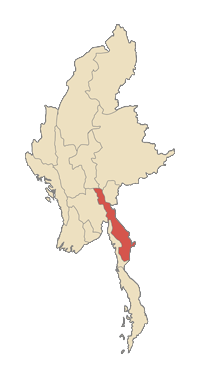Karen people

|
|
| Total population | |
|---|---|
| (9 million[1]) | |
| Regions with significant populations | |
| 7,000,000[2] | |
| 1,000,000[1] | |
| 70,000+ | |
| 11,000+[3] | |
| 5,000[4] | |
| 1,500 | |
| All other countries | 100,000+ |
| Languages | |
| Karen languages, including S'gaw Karen, Pwo Karen, Karenni and Pa'O | |
| Religion | |
| Christianity, Theravada Buddhism, Animism | |
The Karen groups as a whole are often confused with the Padaung tribe, best known for the neck rings worn by their women, but they are just one sub-group of Red Karens (Karenni), one of the tribes of Kayah in Kayah State, Myanmar.
Some of the Karen, led primarily by the Karen National Union (KNU), have waged a war against the central Burmese government since early 1949. The aim of the KNU at first was independence. Since 1976 the armed group has called for a federal system rather than an independent Karen State


No comments:
Post a Comment